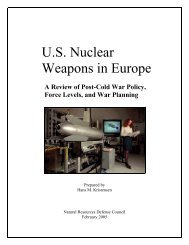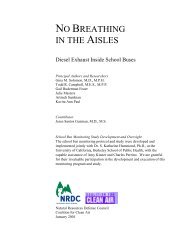NRDC's Ten Best Practices for Textile Mills to Save Money and ...
NRDC's Ten Best Practices for Textile Mills to Save Money and ...
NRDC's Ten Best Practices for Textile Mills to Save Money and ...
Create successful ePaper yourself
Turn your PDF publications into a flip-book with our unique Google optimized e-Paper software.
BEST PRACTICES TO SAvE WATER<br />
NrDc’s responsible sourcing initiative recommends four best practices that could save<br />
mills between 23 <strong>and</strong> 37 <strong>to</strong>ns of water per <strong>to</strong>n of production—between 13 <strong>and</strong> 24 percent<br />
of <strong>to</strong>tal water use.<br />
Leak detection <strong>and</strong> preventive maintenance, improved cleaning<br />
Did you know that a 2 millimeter steam leak can result in the loss of energy equal <strong>to</strong> more than 10 <strong>to</strong>ns of<br />
coal in just one year? Add up all the small leaks in a mill <strong>and</strong> quickly you arrive at considerable losses of both<br />
resources <strong>and</strong> money. Experts estimate that textile facilities can reduce resource use by as much as 10 percent<br />
with an effective leak detection <strong>and</strong> preventive maintenance program. 1 Similar or even larger savings can be<br />
expected from improved oversight of water used in cleaning operations, such as turning off hoses when they are<br />
not being actively used. NRDC’s responsible sourcing initiative conservatively estimated that leaks of water <strong>and</strong><br />
steam were responsible <strong>for</strong> between 1 <strong>and</strong> 5 percent losses of water <strong>and</strong> coal at the mills we assessed, although<br />
in fact these values could be higher based on the literature. 2 Routine investigation <strong>and</strong> repair of leaks in water,<br />
steam, <strong>and</strong> compressed air require almost no investment costs <strong>and</strong> yield instant payback.<br />
How <strong>to</strong> adopt this best practice: Systematically <strong>and</strong> routinely check <strong>for</strong> leaks, replace <strong>and</strong> repair worn hoses, fittings,<br />
etc., <strong>and</strong> more closely moni<strong>to</strong>r efficiency of water use during normal cleaning operations.<br />
Reuse of non-contact cooling water<br />
Because non-contact cooling water is high in quality <strong>and</strong> temperature, it can be beneficially reused <strong>for</strong><br />
processes such as desizing, scouring, washing, or rinsing. In addition, non-contact cooling water’s high<br />
discharge temperature (45°C) <strong>and</strong> volume strain wastewater treatment systems more than necessary. NRDC’s<br />
responsible sourcing initiative found some mills were either not reusing this hot water at all, or were using it<br />
in cold water processes that did not benefit from the heat. We identified three sources of cooling water that<br />
can be most beneficially recaptured <strong>and</strong> reused: the singeing machines, the preshrink machines, <strong>and</strong> the air<br />
compressor system.<br />
How <strong>to</strong> adopt this best practice: Install a water reuse system: pipes, valves, pumps, holding tanks, <strong>and</strong> a control system.<br />
Reuse of steam condensate<br />
<strong>Textile</strong> mills rely on a large amount of saturated steam in the dyeing process. Over the course of its use, some<br />
of that steam converts in<strong>to</strong> condensed water (condensate) that is very high in temperature <strong>and</strong> purity. The<br />
most efficient use of condensate is <strong>to</strong> return it <strong>to</strong> the boiler <strong>and</strong> convert it back in<strong>to</strong> new steam. However, <strong>for</strong><br />
companies that buy their steam from an outside supplier or whose boiler is located <strong>to</strong>o far from the process,<br />
the condensate can serve as water supply <strong>for</strong> washing or desizing, thereby recovering both water <strong>and</strong> heat. In<br />
three mills investigated by the responsible sourcing initiative, condensate was discharted directly <strong>to</strong> wastewater<br />
treatment without reuse. In one such mill, the drying cylinders were producing condensed water at a speed<br />
of 15 kg/h, which translated in<strong>to</strong> 18,975 <strong>to</strong>ns of condensed water per year—2.5 percent of the <strong>to</strong>tal water<br />
consumption in the fac<strong>to</strong>ry. 3 Energy savings accruing from this option are also quite substantial.<br />
How <strong>to</strong> adopt this best practice: Install pipes <strong>and</strong> lines <strong>to</strong> capture <strong>and</strong> return condensate.<br />
Reuse water from pretreatment processes<br />
The water discharged from bleaching <strong>and</strong> mercerizing machines can be collected <strong>and</strong> reused <strong>for</strong> other processes,<br />
instead of discharging it directly <strong>to</strong> wastewater treatment. The water usually meets the quality requirements<br />
<strong>for</strong> scouring after simple treatment (cleanup of fibers). Many mills in the responsible sourcing initiative<br />
investigation did not reuse water from pretreatment processes.<br />
How <strong>to</strong> adopt this best practice: Install pipes, water tanks, <strong>and</strong> electrical pumps <strong>to</strong> s<strong>to</strong>re <strong>and</strong> return water<br />
<strong>to</strong> the process.
















